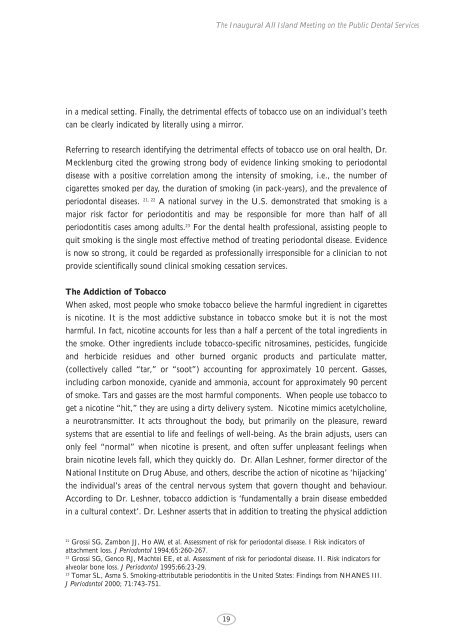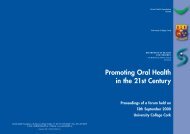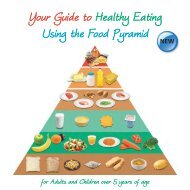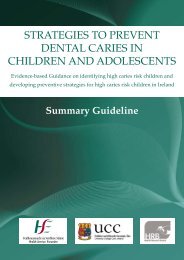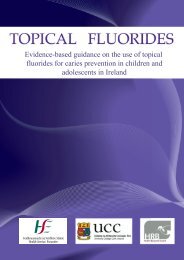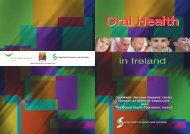Inaugural All Island Meeting on the Public - Dental Health Foundation
Inaugural All Island Meeting on the Public - Dental Health Foundation
Inaugural All Island Meeting on the Public - Dental Health Foundation
You also want an ePaper? Increase the reach of your titles
YUMPU automatically turns print PDFs into web optimized ePapers that Google loves.
The <str<strong>on</strong>g>Inaugural</str<strong>on</strong>g> <str<strong>on</strong>g>All</str<strong>on</strong>g> <str<strong>on</strong>g>Island</str<strong>on</strong>g> <str<strong>on</strong>g>Meeting</str<strong>on</strong>g> <strong>on</strong> <strong>the</strong> <strong>Public</strong> <strong>Dental</strong> Services<br />
in a medical setting. Finally, <strong>the</strong> detrimental effects of tobacco use <strong>on</strong> an individual’s teeth<br />
can be clearly indicated by literally using a mirror.<br />
Referring to research identifying <strong>the</strong> detrimental effects of tobacco use <strong>on</strong> oral health, Dr.<br />
Mecklenburg cited <strong>the</strong> growing str<strong>on</strong>g body of evidence linking smoking to period<strong>on</strong>tal<br />
disease with a positive correlati<strong>on</strong> am<strong>on</strong>g <strong>the</strong> intensity of smoking, i.e., <strong>the</strong> number of<br />
cigarettes smoked per day, <strong>the</strong> durati<strong>on</strong> of smoking (in pack-years), and <strong>the</strong> prevalence of<br />
period<strong>on</strong>tal diseases. 21, 22 A nati<strong>on</strong>al survey in <strong>the</strong> U.S. dem<strong>on</strong>strated that smoking is a<br />
major risk factor for period<strong>on</strong>titis and may be resp<strong>on</strong>sible for more than half of all<br />
period<strong>on</strong>titis cases am<strong>on</strong>g adults. 23 For <strong>the</strong> dental health professi<strong>on</strong>al, assisting people to<br />
quit smoking is <strong>the</strong> single most effective method of treating period<strong>on</strong>tal disease. Evidence<br />
is now so str<strong>on</strong>g, it could be regarded as professi<strong>on</strong>ally irresp<strong>on</strong>sible for a clinician to not<br />
provide scientifically sound clinical smoking cessati<strong>on</strong> services.<br />
The Addicti<strong>on</strong> of Tobacco<br />
When asked, most people who smoke tobacco believe <strong>the</strong> harmful ingredient in cigarettes<br />
is nicotine. It is <strong>the</strong> most addictive substance in tobacco smoke but it is not <strong>the</strong> most<br />
harmful. In fact, nicotine accounts for less than a half a percent of <strong>the</strong> total ingredients in<br />
<strong>the</strong> smoke. O<strong>the</strong>r ingredients include tobacco-specific nitrosamines, pesticides, fungicide<br />
and herbicide residues and o<strong>the</strong>r burned organic products and particulate matter,<br />
(collectively called “tar,” or “soot”) accounting for approximately 10 percent. Gasses,<br />
including carb<strong>on</strong> m<strong>on</strong>oxide, cyanide and amm<strong>on</strong>ia, account for approximately 90 percent<br />
of smoke. Tars and gasses are <strong>the</strong> most harmful comp<strong>on</strong>ents. When people use tobacco to<br />
get a nicotine “hit,” <strong>the</strong>y are using a dirty delivery system. Nicotine mimics acetylcholine,<br />
a neurotransmitter. It acts throughout <strong>the</strong> body, but primarily <strong>on</strong> <strong>the</strong> pleasure, reward<br />
systems that are essential to life and feelings of well-being. As <strong>the</strong> brain adjusts, users can<br />
<strong>on</strong>ly feel “normal” when nicotine is present, and often suffer unpleasant feelings when<br />
brain nicotine levels fall, which <strong>the</strong>y quickly do. Dr. <str<strong>on</strong>g>All</str<strong>on</strong>g>an Leshner, former director of <strong>the</strong><br />
Nati<strong>on</strong>al Institute <strong>on</strong> Drug Abuse, and o<strong>the</strong>rs, describe <strong>the</strong> acti<strong>on</strong> of nicotine as ‘hijacking’<br />
<strong>the</strong> individual’s areas of <strong>the</strong> central nervous system that govern thought and behaviour.<br />
According to Dr. Leshner, tobacco addicti<strong>on</strong> is ‘fundamentally a brain disease embedded<br />
in a cultural c<strong>on</strong>text’. Dr. Leshner asserts that in additi<strong>on</strong> to treating <strong>the</strong> physical addicti<strong>on</strong><br />
21 Grossi SG, Zamb<strong>on</strong> JJ, Ho AW, et al. Assessment of risk for period<strong>on</strong>tal disease. I Risk indicators of<br />
attachment loss. J Period<strong>on</strong>tol 1994;65:260-267.<br />
22 Grossi SG, Genco RJ, Machtei EE, et al. Assessment of risk for period<strong>on</strong>tal disease. II. Risk indicators for<br />
alveolar b<strong>on</strong>e loss. J Period<strong>on</strong>tol 1995;66:23-29.<br />
23 Tomar SL, Asma S. Smoking-attributable period<strong>on</strong>titis in <strong>the</strong> United States: Findings from NHANES III.<br />
J Period<strong>on</strong>tol 2000; 71:743-751.<br />
19


